NGC Ancients: The Coins and Holiday of Saturn
Posted on 12/12/2023
By
Ben Wallace
NGC Ancients Grader
The god Saturn was an important figure in the ancient Roman world. He was the father of many of the most powerful gods and goddesses, including Jupiter, Neptune and Juno. He was also the god of agriculture, wealth and time, and had a large temple in the Roman Forum.
Despite the importance of Saturn, he rarely appears on coins of the Romans — and when he does, it’s almost entirely during the Roman Republic. He appears on precious few coins of the Roman Empire. The fact that the public treasury in Rome was stored under the Temple of Saturn would, perhaps, be cause for this powerful god to be portrayed on Roman coins more commonly, but this was not the case.
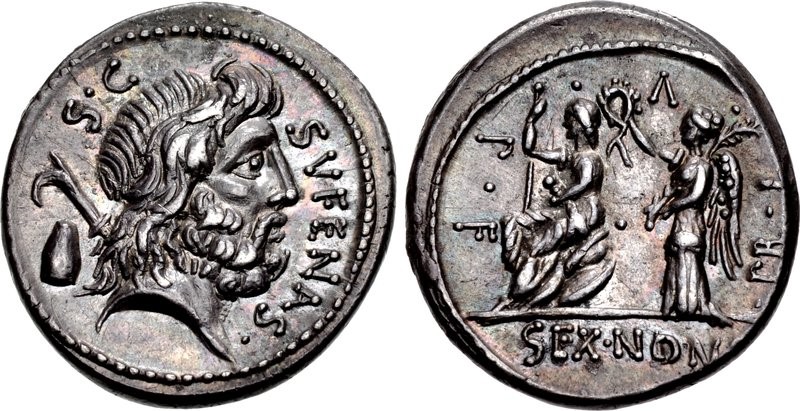 |
Shown here is perhaps the most impressive type portraying Saturn. The above denarius, made in 57 B.C. by the moneyer M. Nonius Sufenas, depicts Saturn opposite a scene of Victory crowning Roma. Scholars do not know why Saturn is presented on this coin.
Saturn usually is portrayed as an older, bearded man with a harpa or sickle over his shoulder. The harpa, a bladed weapon with a distinctive hook near its tip, is traditionally associated with Saturn for its use in agriculture and as the weapon he used to castrate his father. On this particular coin, there also is a beatylus, a conical stone of religious importance.
The importance of Saturn in the Roman world was celebrated during Rome’s most important holiday, the Saturnalia. This festival in the middle of December lasted for days. It was a time of feasting, gift giving, gambling and, of course, drinking! Sometimes in this period, roles would be reversed — slaves and servants would instead be served by their masters. The traditional greeting of ‘io Saturnalia’ could be heard throughout the city.
Through the centuries, as the Roman Empire became Christianized, Saturn and his holiday, Saturnalia evolved, in some ways that influenced the traditions of Christmas, and even our modern portrayal of ‘Father Time.’
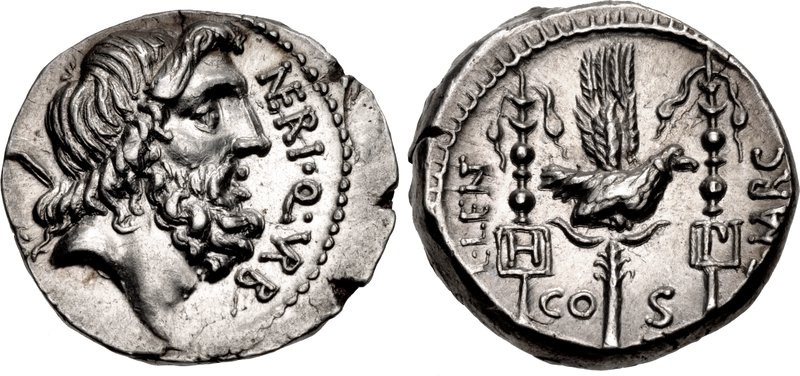 |
The above silver denarius, made in 49 B.C. under the trio of moneyers Cn. Neris, L. Lentulus and C. Marcellus, shows a portrait of Saturn (this time adorned only with a harpa) that’s quite similar to the one on the previous denarius.
The reverse type shows a legionary eagle between two military standards. The portrayal of Saturn opposite these military symbols makes sense because one of the moneyers, Nerius, was then serving as a Quaestor Urbanus, and had some authority over the treasury, and Saturn’s Temple was the repository for some of Rome’s important military standards.
 |
This silver denarius serratus was made under the moneyer L. Memmius Galeria in 106 B.C. The obverse shows Saturn with a harpa. The reverse has the goddess Venus driving a biga while Cupid flies above holding a wreath.
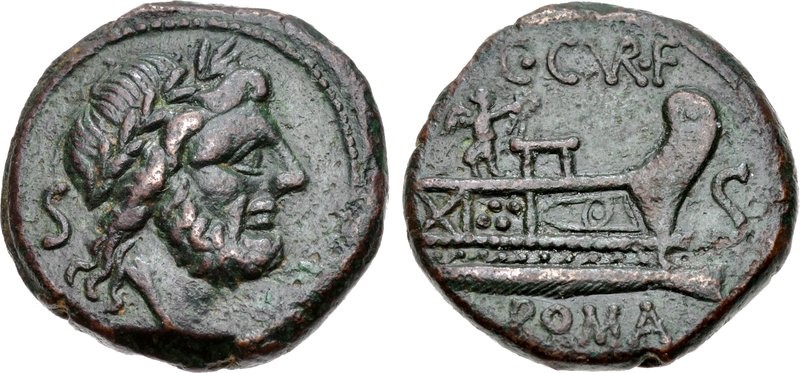 |
A good number of bronze coins of the Republic feature Saturn, including this Semis made in 135 B.C. under the moneyer C. Curiatius f. Trigeminus. The obverse shows the head of Saturn with a denomination mark behind. The reverse shows Victory on the prow of a war galley.
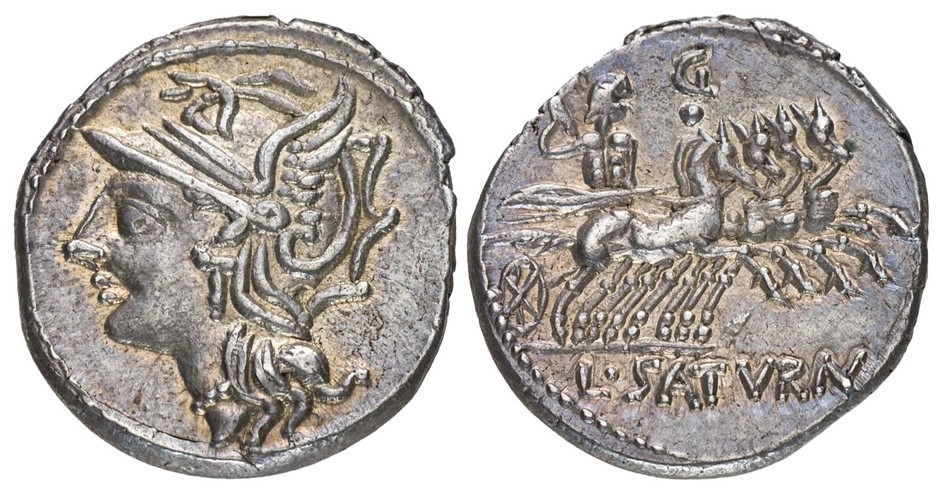 |
The above denarius was made under the moneyer Lucius Appuleius Saturninus in 104 B.C. The obverse has the helmeted head of Roma while the reverse shows Saturn wielding a harpa as he drives a quadriga, a chariot of four horses. As might seem obvious — even to the modern observer — this moneyer presumably depicted Saturn as a punning allusion to his own family name.
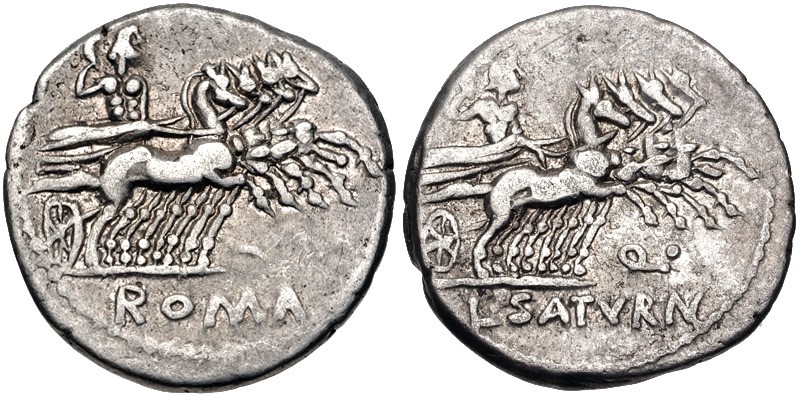 |
Another coin of the Republic that shows Saturn is this silver denarius above, made by the same moneyer as the previous coin. However, it is among the most peculiar of all Roman Republican coins in that it features Saturn racing in a quadriga on both sides!
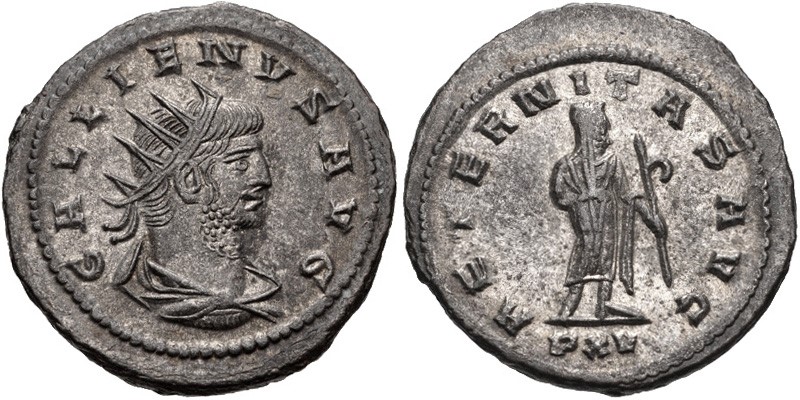 |
We’ll end our survey by jumping ahead nearly three centuries for a most unusual appearance of Saturn. This billon double-denarius, made for the emperor Gallienus (A.D. 253 to 268), shows a veiled Saturn holding a harpa. The design is accompanied by the inscription AETERNITAS AVG – a pledge for the ‘eternity of the emperor’ — a concept that seems especially appropriate for this god.
All photos courtesy of Classical Numismatic Group.
Stay Informed
Want news like this delivered to your inbox once a month? Subscribe to the free NGC eNewsletter today!
